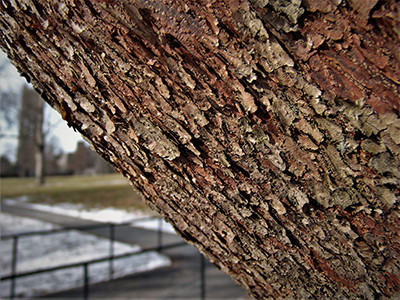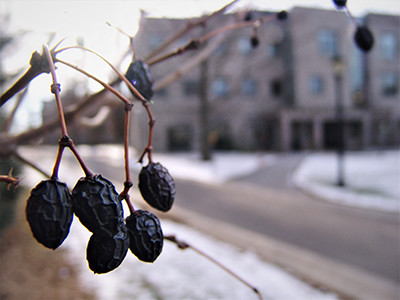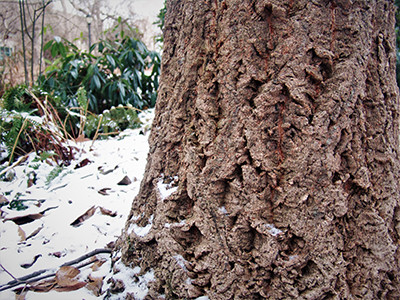
Plants of the Week: February 5

by John Bickel
Acer (griseum x maximowicziana) ‘Rochester Hybrid’
Off the southeastern corner of McCabe Library is a beautiful old specimen of the maple hybrid Acer griseum x maximowicziana ‘Rochester Hybrid’. The bright, cinnamon-brown, reddish bark is a sight to behold against a bleak winter background. The bark exhibits what appears to be an even mixture of characteristics of both parents. The splitting patterns of the furrows are small and fine as in A. maximowicziana, while it has the papery, peeling features of A. griseum.
The leaf shape, though not present this time of year, seems to favor that of the A. griseum parentage with oddly-lobed margins of the leaflets of the trifoliate-dissected leaf. The hybrid is frequently referred to as Acer griseum x nikoense reflecting the synonymous species designation of nikoense and maximowicziana per the latest edition of the Flora of China. photo credit: J. Bickel

Chionanthus retusus ‘China Snow’
Bark and berries can be a real treat for the eyes on a frigid January day. While wandering close to the back of Beardsley Hall, I found a small Chinese fringetree holding its own against the bitter winds. The inky-blue berries of this particular plant have persisted and dried to reveal peculiar geometric ridge patterns all over. Up close, that, paired with the cinnamon-brown, lenticel-pocked, laterally-peeling bark, makes for an other-worldly little shrub. An eastern Asian species, the cultivar ‘China Snow’ boasts a smaller stature than the species and a uniquely dense show of the fluffy white flowers that emerge in early summer. photo credit: J. Bickel

Quercus variabilis
The deep, furrowed, and highly textured bark of the Chinese cork oak Quercus variabilis struck me today in the Sibbett Garden near the Scott Outdoor Amphitheater. The furrows were nearly an inch deep, which seemed unlikely of a tree that was planted nearly twenty years ago as the records insist.
Though the common name carries the suggestion, the bark of Q. variabilis is not widely used for the production of bottling cork material as compared to the true cork oak Quercus suber. Quercus variabilis hails from a wide area in eastern Asia and grows to heights of nearly 100 feet. The leaves differ significantly from a layperson’s impression of what an oak leaf should look like. They are lanceolate in shape, unlobed, and have serrated margins. photo credit: J. Bickel





Wendy
Posted at 12:40h, 07 FebruaryI really enjoy these photos and info, especially the different varieties, most of which I have never heard. Thank you.
Becky Robert
Posted at 16:28h, 07 FebruaryThank you for the nice comment, Wendy. We love to share our passion for plants and explore the variety nature has to offer.
Becky Robert
Scott Arboretum
jed johnson
Posted at 10:58h, 11 FebruaryGood Morning
I am the caretaker of a single A. maximowicziana here on our land in New England.
Acer griseum also graces our land here along with other beautiful maples such as the elegant moosewood (Acer pensylvanicum)
and the lovely Shantung maple (A. truncatum).
The quiet beauty of the A. maximowicziana is amplified by the trees juxtaposition with a commanding Betula alleghaniensis.
When I am out daydreaming amongst these friends I sense only their siren song descending from their buoyant crowns, love… hope…
love… hope… love… hope… Thank You!